Outreach and Extension Programs
To disseminate up-to-date research results to turfgrass professionals and homeowners, Penn State's turfgrass program has a strong outreach component. Cooperative Extension professionals statewide use workshops, consultations, and publications to cover topics such as diagnosing and managing turf diseases, selecting grass varieties, controlling weeds, and recycling grass clippings. Labs at Penn State are available for turf disease diagnosis and soil testing.
While newsletters keep professionals up-to-date on the latest industry news, 15 percent of the state's more than three million homeowners receive lawn care information directly from Penn State specialists and Cooperative Extension offices. Many more homeowners receive this information indirectly through garden centers, nurseries, newspapers, and magazines. Local Cooperative Extension meetings and workshops throughout Pennsylvania draw hundreds of attendees each year.
Research field days, initiated in the early 1930s and held every other year at Penn State, provide an opportunity for turfgrass managers from around the state to look at turf selections in evaluation plots and to learn about the results of new turfgrass research. These field days attract hundreds of attendees.
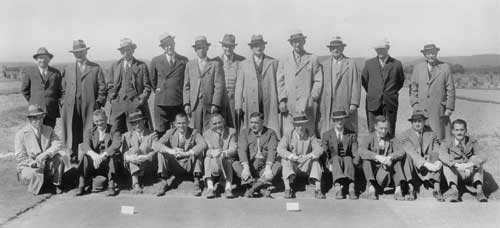
Attendees from the Pittsburgh area at the first annual Field Day Meeting, September 1937. Fred Grau, turfgrass extension specialist, is seated at the far right.
Penn State turfgrass specialists also participate in annual conferences and trade shows that attract more than 4,000 turfgrass professionals and industry representatives each year. Four regional conferences throughout the state provide easy access for turfgrass professionals based in Pennsylvania.
The first annual fine turf conference, held at Penn State in 1929, featured sessions such as Fertilizations of Greens and Fairways, Landscape Problems, and Machinery and Drainage. "Before any of the regional conferences, the only turf conference was at the State College Hotel," says Thomas Watschke. "Burt Musser, Fred Grau, and some others ran the early conferences, which were tailored primarily for golf turf people." These meetings attracted twenty-five to thirty people in the beginning. As attendance started to grow, the conference moved from the downtown State College Hotel to the Temporary Union Building (TUB) on campus, then to the Keller Conference Center on campus.
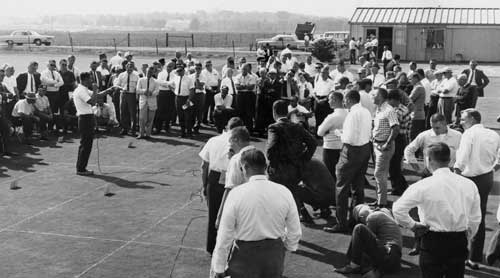
Joseph M. Duich discusses new grass varieties at the field days, 1964.
In addition to early turfgrass conferences, Penn State offered a Greenkeepers Short Course, which ran from 1931 until 1940. Short courses typically ran for four weeks and were designed to overlap with the annual conference, for those wanting more in-depth study. According to the program from the first Greenkeepers Short Course, "This course is designed for greenkeepers, green chairmen, superintendents of parks, gardeners, and others interested in fine turf problems. Instruction is given . . . in the broad underlying problems which deal with practical turf management. No special educational preparation is required, anyone who is interested and able to read and write being eligible. It should be remembered, however, that the course is designed especially for those who have had some experience in fine turf management." Room and board for the short course, incidentally, was $9.50 to $10.50 per week.
"The conferences we have today are so different from the ones in the old days," says Stanley Zontek, a 1970 Penn State turfgrass graduate and director of the USGAGreen Section, Mid-Atlantic Region. "In the early days, you'd go to the educational sessions and then go up to somebody's room to drink beer and smoke cigarettes and play cards. Those informal gatherings were full of questions and answers and direct problem solving. You'd sit down with Joe Duich and say, 'Okay, Joe, you were up there today talking about this pest control product. Well, I can tell you I tried it and it didn't work.' Then he'd say, 'Well, maybe you didn't do it right.' And so it would go."
In 1955, the Pennsylvania Turfgrass Council was established and began co-sponsoring the annual Pennsylvania Turfgrass Conference. As the event grew in popularity and attracted more attendees, it became necessary to find an even larger meeting location. 'Around 1982, a plan was hatched to move the conference to Hershey," says Watschke. "At Hershey we could have a trade show along with the conference, and we thought it would be great. It turns out, though, that the alumni didn't like it. They wanted to come back to Penn State. They wanted old home week. So we moved it back to campus in 1990 and took it to the Nittany Lion Inn, and that is the current site of our Pennsylvania Golf Turf Conference each November."
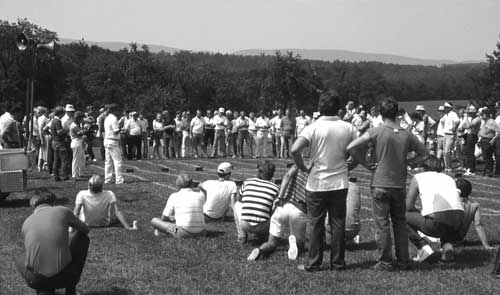
Field Days, 1984.
In the early 1970s, Penn State Cooperative Extension specialist Jack Harper and Philadelphia County agent Bill White put plans in motion for a Southeastern Pennsylvania Turf School, which offered educational sessions but no industry component. That event grew into the current Eastern Pennsylvania Turf Conference and Show. A few years later, a Western Pennsylvania Turf School was initiated, and it also grew into a full-blown conference and trade show, held annually in Monroeville. The Northeastern Pennsylvania Turf Conference and Trade Show, a one-day event held in the Poconos region, caters to turfgrass professionals in the Scranton/Wilkes-Barre area.
"The thinking behind regional conferences was that they would attract people who might not have the money to travel to Penn State and spend the night," says Joseph Duich. "A lot of golf course superintendents at smaller golf courses can't afford that, and so we decided to bring the conference to them."
The conferences initially attracted golf course superintendents. As the turfgrass industry evolved, the audience expanded to include landscape contractors and grounds managers. In the mid-1980s, when the Pennsylvania Department of Agriculture established new regulations for pesticide application, the regional conferences began offering credits for recertification. "At that point," says Watschke, "attendance went through the roof."
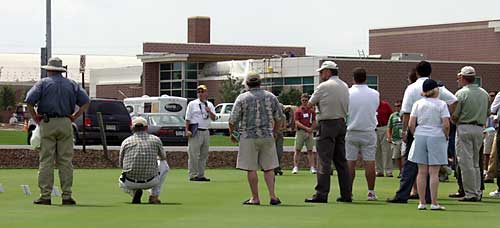
Penn State Turfgrass Alumni Club
Frank Dobie is fond of saying that the Penn State Turfgrass Alumni Club began with a napkin. In the late 1960s, Dobie and Tom Burrows (both two-year class of 1960), along with professor emeritus Joseph Duich, were having coffee at a Penn State turfgrass conference, discussing the idea of forming an alumni association. "We all agreed to keep it simple," says Dobie, who is now superintendent and general manager of the Sharon Golf Club in Ohio. "We wrote out the bylaws on a napkin."
The bylaws stated that the alumni club would have three officers: a president, a vice president/treasurer, and a secretary. Each would serve a three-year term, with the vice president moving into the president's position after three years. "Tom Burrows, now a soils consultant in Florida and I flipped a coin for who would be he first president," Dobie remembers. "I lost, so I became president! Tom served as V.P., and we selected Bruce Sering as secretary."
When it is time to choose a new secretary, the current president and vice president/treasurer confer. "They look around and consider who they want to bring on board," says Dobie. "We try to get people from different geographic areas of the country, people who have demonstrated responsibility. Then the president and V.P. make a verbal nomination. It's never in writing, and at the meeting they never get any nays."
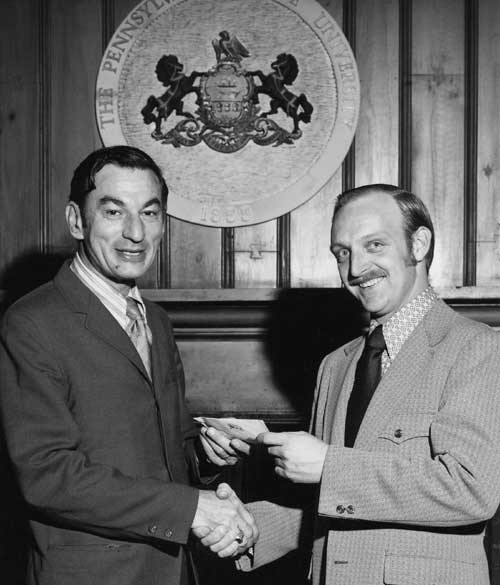
Frank Dobie (right), of the Musser International Turfgrass Foundation, provides Joseph M. Duich with funding for Penn State's turfgrass project, 1972.
In the early days of the alumni club, dues were between five and ten dollars per year. The club began holding a luncheon meeting each year at the Golf Course Superintendents Association of America's national convention. Joseph Duich kept a listing of all turfgrass graduates, and he and his secretary would mail the meeting notes.
Because of GCSAA scheduling conflicts, annual lunch meetings later became breakfast meetings. Today, about 100 alumni club members attend the breakfast meetings to become re-acquainted, network, and learn about the latest turfgrass research developments at Penn State. Joseph Duich has traditionally presented research updates, and in more recent years Thomas Watschke and the late George Hamilton have also addressed alumni on Penn State turfgrass activities.
The alumni club uses its treasury both for club activities and as a benevolent fund. Every five years or so, the club has held dinner cruises in cities such as New Orleans and San Francisco. A member who had an accident on the job received $1,500 from the club, and one year there was a donation to the Musser Foundation for $5,000. At each annual meeting, a cash award is presented for an outstanding technical paper.
John Pollok, a 1987 graduate of the two-year program and currently director of agronomy at Robinson Ranch in Santa Clarita, California, serves as current president of the alumni club. Calling his appointment to serve as president "the highest honor I could have received," Pollok is particularly proud of the Penn State turfgrass alumni's efforts to help the family of Duff Shaw, a classmate of Pollok's who passed away in 1992. Shaw was superintendent of the North Ranch Golf Club when he became terminally ill, and Pollok arranged a golf tournament to raise money to help with medical expenses as well as provide financial help to Shaw's wife, Kristi, and daughter, Erin. More than $32,000 was raised at the initial tournament, and to date, following the 12th annual tournament in 2003, $247,500 has been raised. This money also co-sponsors a Penn State scholarship in Shaw's name and is placed in the Southern California Golf Course Superintendents Benevolent Fund, which was established to help members and their families.
"As huge as the turf industry is, it's a people business," says alumni club member Stan Zontek, a 1970 Penn State graduate and director of the USGA Green Section, Mid-Atlantic Region. "I think the PSU turfgrass alumni association is the biggest in the world, but it's close-knit. That's why I go to the meeting each year--to see people, to shake hands."
"The alumni club started simple and has remained simple," adds Dobie. "We wanted it to be a gathering of old friends, and that's what it is."

